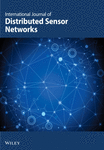Distributed Nonfragile Guaranteed Cost Filter Design for Nonlinear Systems With Sensor Networks
Abstract
This paper addresses the distributed filter design issue of nonlinear systems in sensor networks. Furthermore, by considering the synthesized filter gain fluctuations, the nonfragile design scheme is developed to improve the implementation robustness and applicableness. Since the nonlinear system model is more practical and general to describe the real-world dynamical systems, the nonlinear objective system measured by a sensor network grouped by sensor nodes is investigated. Moreover, in order to solve this theoretical filtering problem, the control theory and system theory are applied with control model transformation. More precisely, all the filters are supposed to be designed with the measurement of each sensor in the sensor network. Firstly, the distributed filtering problem is converted to the stability of filtering error system. Then, sufficient convex optimization conditions are accordingly established to ensure the desired H∞ disturbance attenuation level with the desired guaranteed cost performance. Then, distributed filter gains can be derived by means of convex optimization method. Finally, the illustrative simulation of a nonlinear system with four sensor nodes is given to demonstrate the usefulness and correctness of our filter design.
1. Introduction
The last decades have witnessed a rapid development of sensor technologies, where numerous theoretical researches and practical applications can be found in industrial processes, medical services, engineering electronics, and other information collection scenarios [1–5]. In particular, increasing attentions have been paid to the sensor networks, which means that a large number of sensor nodes are grouped and the data fusion is achieved by network communication. Since a single sensor commonly has limited communication capability and constrained computational ability, significant advances can be obtained by sensor networks, such as high efficiency, high robustness, and high reliability [6–9]. However, as a fundamental topic of sensor measurement, the filtering problem is more complicated for the sensor networks due to the multiple sensors and intergraded data communications. Furthermore, as certain centralized signal processing over large sensor networks is impractical or very expensive, it is reasonable and effective to develop distributed framework and algorithms by each sensor node. Under this context, each sensor node can perform local information processing and information exchanges collectively [10–12].
For the distributed filtering problem of sensor networks, the consensus-based methods have been proved to be useful in many circumstances. As a result, some remarkable results and well-known approaches can be found in the literature [13–16]. Meanwhile, it should be noticed that the filter gain fluctuations should not be neglected, which may lead to undesirable filtering performance or even filtering failures. Moreover, there always exist parameter uncertainties and environment interruptions in practical filter implementation. In order to deal with practical applications of filters, the nonfragile filtering strategy should be designed accordingly [17–19]. In fact, the nonfragile control issues have been extensively studied for control systems and many effective methods are reported with controller or estimator gain fluctuations. However, it is worth mentioning that the distributed filtering analysis and synthesis are more challenging with nonfragile designs. On the other hand, by taking into account the practical cost of sensors networks, the guaranteed cost performance should be addressed, where an upper bound of the prescribed performance should be satisfied and minimized during the distributed filtering [20–22]. Unfortunately, until now, the distributed nonfragile guaranteed cost filtering problems of nonlinear systems via sensor networks have not been fully studied under the H∞ framework and remain opening areas, which motives us for this research.
In our work, the distributed filtering issue of sensor networks is discussed for a sort of nonlinear systems with external disturbances. Compared with most existing results, the main contributions can be listed as the following aspects. (1) Firstly, the distributed nonfragile filter design problem is investigated in the presence of the practical gain fluctuations, and a unified framework for sensor networks is proposed to estimate the true states. With this strategy, the distributed filters are more applicable for practical sensor network implementations. (2) Secondly, the quadratic guaranteed cost performance is introduced on the basis of sensor networks, where sampled data are utilized by the sensors. (3) Thirdly, the computational distributed filter design method is established based on the linear matrix inequality convex optimization, such that the desired filter gains can be designed with feasible solutions effectively.
The remainder parts of our work are presented as follows. In Section 2, the distributed filter model is formulated based on sensor networks and the model transformation with essential preliminaries is presented later. In Section 3, sufficient conditions are derived by filter error model and distributed filter gains are designed accordingly. In Section 4, our proposed filtering approach is applied to simulation for efficiency demonstration. In Section 5, the paper is concluded with some further remarks.
1.1. Notations
ℝn denotes n dimensional Euclidean space. ℝm×n represents the set of m × n real matrices. A matrix M > 0 means that M is positive definite. ⊗ stands for the Kronecker product. ∗ denotes the ellipsis terms in symmetry matrices.
2. Preliminaries and Problem Formulation
Remark 1. The nonlinear system models have been widely utilized to model the practical dynamical systems. In this paper, the Lipschitz nonlinear function is adopted to describe the nonlinear dynamics, which would lead to more challenging issues for control system analysis and synthesis
In order to enhance the filter design for output estimation, a sensor network consisting of N sensor nodes is constructed under distributed communication network. Under this framework, the network topology of this sensor network is described by a directed graph , , with and being the sets of nodes and edges, and is the weighted adjacency matrix and presents the local neighbors of sensor i. More precisely, assume that aij > 0 when sensor i receives information from sensor j with aii = 1, and aij = 0 when there is no communication between sensor i and sensor j [23]. Without loss of generality, all the sensors in the sensor network share a unified sampling sequel with time-varying sampling period defined by tk+1 − tk = h(t) > 0, k = 0, 1, 2, ⋯. In addition, it is assumed that , where is a known constant.
Consequently, the sampled-data measurement for sensor i can be represented as follows [24]:
Consequently, on the basis of above sensor network, the distributed filters in sensor network can be designed as follows:
Based on the above model, we can define the following distributed filter errors:
As a result, the dynamics of distributed filter errors can be deduced as follows:
Eventually, we can formulate the following augmented filtering dynamical system:
Then, the following definition can be presented for the distributed filters, such that the augmented filtering dynamical system can effectively achieve desired H∞ disturbance attenuation performance with desired guaranteed cost.
Definition 1 (see [25], [26].)The H∞ disturbance attenuation performance is defined by
Then, the H∞ performance with desired guaranteed cost is said to be satisfied for the augmented filtering system under zero initial conditions, if there exist parameters γ > 0 and for all nonzero w(t), such that it holds that J∞ < 0 and
Remark 2. Compared with common H∞ performance, the guaranteed cost H∞ performance for filtering problems is more general, where the prescribed cost can be ensured while dealing with the disturbance affections. On the other hand, some practical applications focus more on the optimal control performance, such that it is necessary to design the optimal guaranteed cost control strategies. When the guaranteed cost performance is introduced into the distributed filter design procedure, it means that an upper bound on the closed-loop value of quadratic cost function can be established.
To this end, the purpose of this paper is to design desired distributed filter gains to achieve the above guaranteed cost H∞ performance in sensor network [27, 28]. Before proceeding further, some important lemmas are introduced for deriving the main results.
Lemma 2 (see [30].)For matrix MT = M, and F1 and F2 being real matrices of appropriate dimensions with O(t) satisfying OT(t)O(t) ≤ I, it holds that , if and only if there exists a scalar ε > 0 such that , or equivalently
3. Distributed Filter Gain Design
In this section, we will derive sufficient convex optimization conditions to design the distributed filter gains with detailed proofs.
Theorem 1. With parameter , the augmented filtering error system can achieve guaranteed cost H∞ performance with distributed filter gains Kij, i, j = 1, 2, ⋯N, if there exist matrices ℙ > 0, ℚ > 0, and ℝ > 0, such that the following convex optimization condition Θ < 0 can hold, where
Furthermore, the cost performance Jc can be guaranteed by
Proof 1. By applying the virtual delay method, one can obtain that
Choose the following Lyapunov–Krasovskii function for augmented filtering system (9)
Then, it can be derived along with evolution of V(t) by
From the plant model nonlinear function, it yields that
Subsequently, it can be derived that
Furthermore, it holds that
Considering the external disturbances, one has that
Therefore, it follows by Schur complement lemma that when Θ < 0 holds, then . Furthermore, under zero initial conditions and for all nonzero w(t), it can be verified that
Meanwhile, one can derive that when w(t) = 0, one has that
In the end, from Definition 1, one can verify that the guaranteed cost and H∞ performance can be achieved, which completes the proof.
Remark 3. The novel sufficient convex optimization is utilized in this paper based on the linear matrix inequality method, which has been widely used for control system analysis and synthesis. The feasible solutions of the convex optimization conditions can be easily solved by Matlab or other mathematical software [31].
By the above established theorem, the following theorem is presented for solving the optimized filter gains.
Theorem 2. With parameter , the augmented filtering error system can achieve guaranteed cost H∞ performance, if there exist matrices with , , , and , such that the following convex optimization condition Ψ < 0 can hold, where
With above feasible solutions, the desired distributed filter gains Kij, i, j = 1, 2, ⋯N, can be calculated as follows:
Furthermore, the cost performance Jc can be guaranteed by
Proof 2. Let and one has where
Then, by employing Lemma 2 to the above condition, the rest of the proof can be easily completed by matrix manipulation.
Remark 4. In this work, the time-varying sampling period is considered, which is more general for practical sensor network implementation. Furthermore, the maximum value of can also be optimized by solving the above convex conditions as
Remark 5. The established results are in the form of strict linear matrix inequality convex optimization. It should be pointed out that as the number of sensor nodes in the sensor network increases, the number of matrix variables of linear matrix inequality would increase accordingly. This implies that there is a computational complex tradeoff between the sensor nodes and the feasible filter design solutions.
4. Illustrative Example
In this section, we will perform an illustrative example to show the effectiveness of our distributed filter design.
In order to obtain the true state of nonlinear system, a sensor network consisting of four sensors is constructed, where Nodes 1, 2, 3, and 4 are grouped as a sensor network with information communications. In this sensor network, each sensor node can measure the objective nonlinear system state with measurement output and the corresponding network topology is depicted in Figure 1 and the time-varying sampling period is assumed to be h = 0.2 s and h = 0.15 s [32, 33].
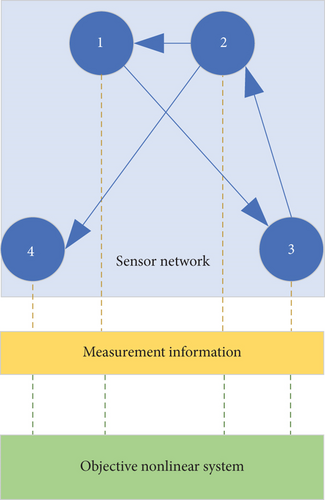
With the above parameters, the external disturbance w(t) is assumed to be a band-limited white noise with power 0.01; the corresponding filtering error dynamics in the sensor network are depicted in Figures 2, 3, 4, and 5, such that the designed filters can well obtain the true states despite external disturbances. These simulation results can support our theoretical findings.
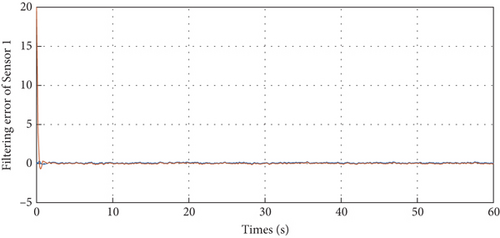

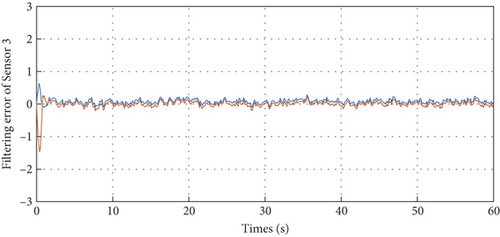
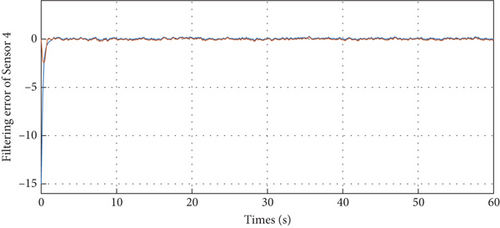
In addition, when the external disturbance is assumed to be w(t) = 0.2sin(t), the filtering error dynamics in the sensor network are shown in Figures 6, 7, 8, and 9, from which one can see the filters can also well obtain the true states despite external disturbances. Furthermore, according to the linear matrix inequality convex optimization, the maximum value of can also be optimized as 0.57 s and the cost performance can be calculated by Theorem 2 as 1221. Meanwhile, it is noted from Figure 10 that under zero initial condition, the ratio to , which means that H∞ disturbance attenuation level is less than the prescribed value and the H∞ performance can be then satisfied. These simulation results can well demonstrate the filtering performance as expected.
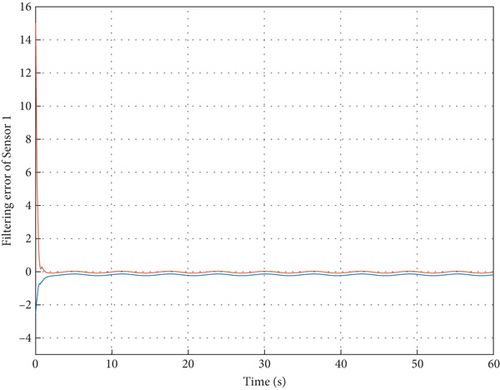
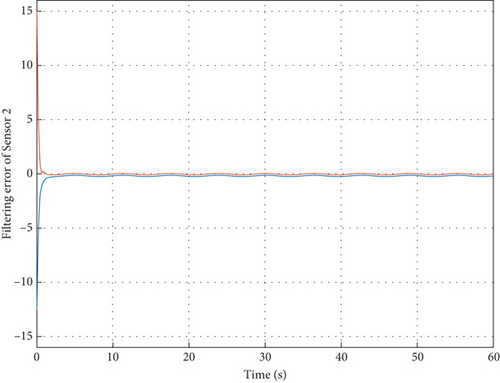
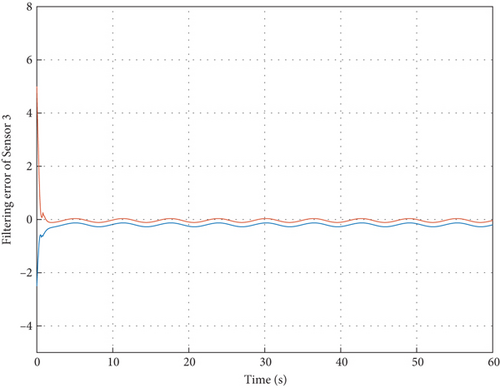
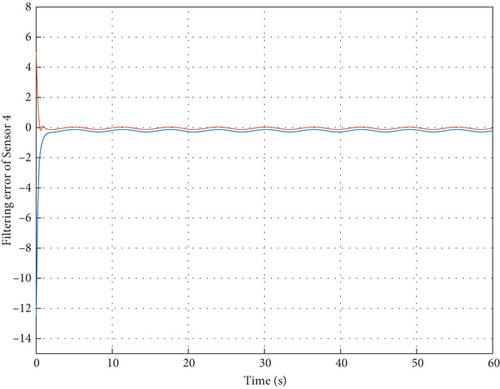
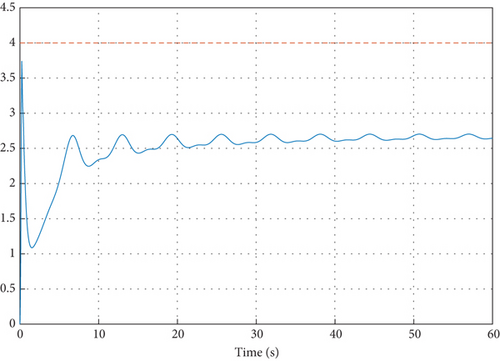
Moreover, Figure 11 depicts the relation between the chosen value of and the cost performance . As a result, it can be found that choosing bigger value of would lead to higher cost performance, which implies that the sampling period of sensor network should be chosen properly.
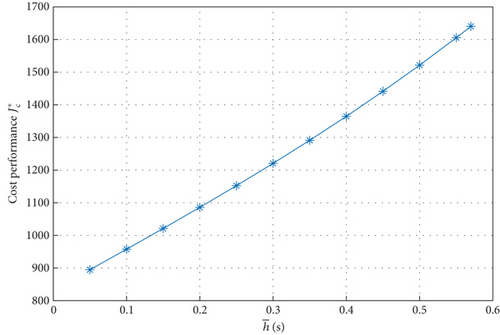
5. Conclusions
The guaranteed cost H∞ distributed filtering problem for nonlinear system has been studied based on sensor network in our paper. In particular, we have considered the possible distributed filter gain fluctuations to improve the robustness of filter design. Based on the formulated augmented filtering system, sufficient conditions have been established by using the Lyapunov–Krasovskii method to ensure the guaranteed cost H∞ performance. Furthermore, the distributed filter gains have been calculated by solving the convex optimization problem. In the end, an illustrative example has been given for validating the correctness of our established design results. In the future, one interesting topic toward current researches would be the fault detection filter design issues, which is also important for sensor networks.
Conflicts of Interest
The authors declare no conflicts of interest.
Funding
The authors disclosed receipt of the following financial support for the research, authorship, and/or publication of this article: This work was supported by the National Natural Science Foundation of China under Grant 52174352.
Acknowledgments
The authors are grateful to the editor and reviewers for their valuable suggestions which improved this article.
Open Research
Data Availability Statement
All data supporting the findings of this study are available within the article.



